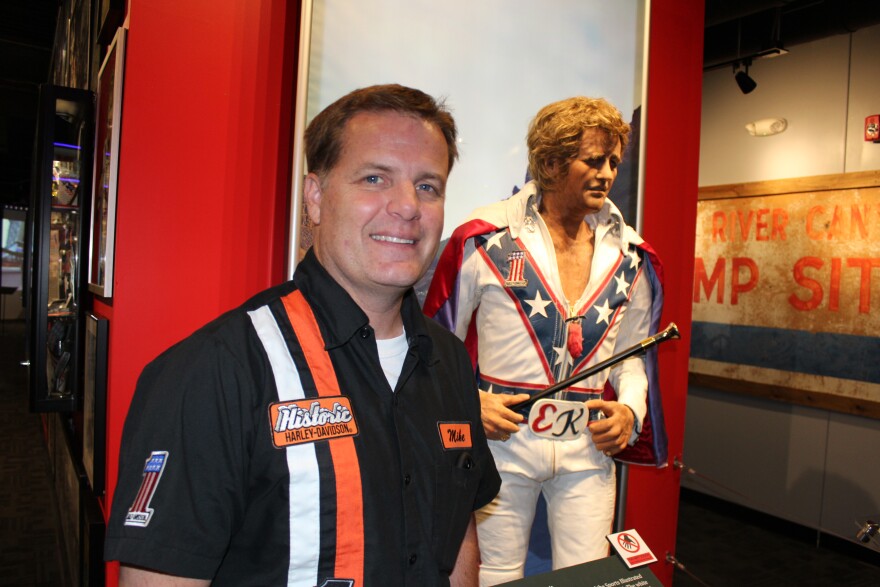Half a century ago war, protests, and political scandal rocked the United States. Sound familiar? But, out of all that a small-time hoodlum from Butte, Montana rocketed into national prominence, on a motorbike. Evel Knievel's career took off like a rocket, but crashed even faster. Now a new museum celebrates all that is Evel.

Robert Craig Knievel was the kind of kid you'd probably medicate these days— an ornery, reckless small town guy always in trouble with the law. He tried lots of careers: mining, insurance, semi-pro hockey, and selling Honda motorcycles, before declaring himself a professional daredevil. He started with a jump over two mountain lions, and a box of agitated rattle snakes. By his late 20s he'd hustled his way into the national spotlight.
"Evel Knievel was an original. And to a lot of people, young people, he was a super hero," says Brad Zimmerman, director of the Evel Knievel Museum, in Topeka, Kansas.
Evel certainly dressed the part. With his flamboyant red, white and blue, motorbikes, helmets, leather jumpsuits, and, yes, capes, Knievel was part Elvis, part Liberace, part John Wayne.
"True dare devil," says Zimmerman. "Seat of the pants. Not much science. Just I can do this, so I'm going to do it. If you look at most of his motorcycles, they did not have speedometers on them."
Yeah, no speedometers, no special shocks, just instinct guiding heavy race bikes flying off wooden ramps. Knievel, made most of his 168 jumps, but he crashed 19 times, pulling himself up wreck after wreck to jump again. He attracted devoted fans like Rodney Brown.
"Just amazing he survived all the crashes and all the bones broken," says Brown, standing in the Evel Knievel museum. "He didn't care. He just did what he wanted to do, and lived his life, and that's the way it was."
Knievel's hutzpah, tenacity and flair vaulted him to international superstardom, and big money. Zimmerman says Knievel made millions just licensing his name.
One wall features a display of Evel's licensed products. "He had everything from barbeque sauce, to motor oil, to toys, pinball machines, slot machines, bicycles, you name it, they were putting Evel's name on it," says Zimmerman smiling at the display.
And around a corner, in freestanding showcase worthy of crown jewels, rests a savagely battered old motorcycle helmet. It's from Evel Knievel's most famous, and spectacular crash.
"That is the Caesars Palace helmet," boasts Zimmerman. "That's a pretty famous piece. Everybody's seen that video and there's the original helmet."
Caesar's Palace Crash
The film of Knievel trying something no one had ever attempted before, landing short, being tossed head first on to the pavement and tumbling like a ragdoll for some 60 feet, was broadcast over and over.
"The crashes are what made him famous," says Mike Patterson.
Patterson, who owns Historic Harley Davidson, which, not coincidentally, is right next to the new Evel

Knievel Museum. Patterson is bankrolling and spearheading the museum displaying artifacts collected largely by Latham McKay. Patterson had life changing moment seeing Knievel jump, at the Kansas State Fair in Hutchinson when he was four years old. He remembers the day vividly.
"I was sitting next to my cousin, and I remember the sound. I mean there was a covered grandstand, so the bike's engine would kind of echo through the grandstand and it was kind of an eerie sound," recalls Patterson, of Knievel's pre-jump wheely show. "And, I remember just hoping he would go, waiting for him to go, sitting there on the edge of my seat, until he finally went."
Knievel cleared the 10 semi-trucks beautifully, that day in 1971, and locked in a fan who would eventually build him a museum.
"I think it does all kind of go back to that day, and the inspiration from that moment," says Patterson.
Heroic as he seemed though, Knievel's heavy drinking, gambling, and surly disposition weighed him down. He spent money even faster than he made it. His Snake River Canyon, rocket "skycycle" jump was a dismal failure. And when he was jailed for beating his former publicist with a baseball bat, the Evel Empire collapsed.
"When it flamed out, it flamed out pretty fast," says Patterson. "And I think, too, that's probably why there wasn't an Evel Knievel museum before now."
Knievel died of lung disease in 2007, but not before inspiring a huge industry around extreme sports, and a generation of risk-takers. Zimmerman says it's time to celebrate Evel.
"Evel had a big ego. When you're a star you have lots of ladies throwing themselves at you. Alcohol was something that he was interested in," admits Zimmerman. "But for the most part we're focused on the positives of Evel here in the museum."
Frank Morris is a national correspondent and senior editor at KCUR, a partner in the Kansas News Service. You can reach him on Twitter @FrankNewsman.


